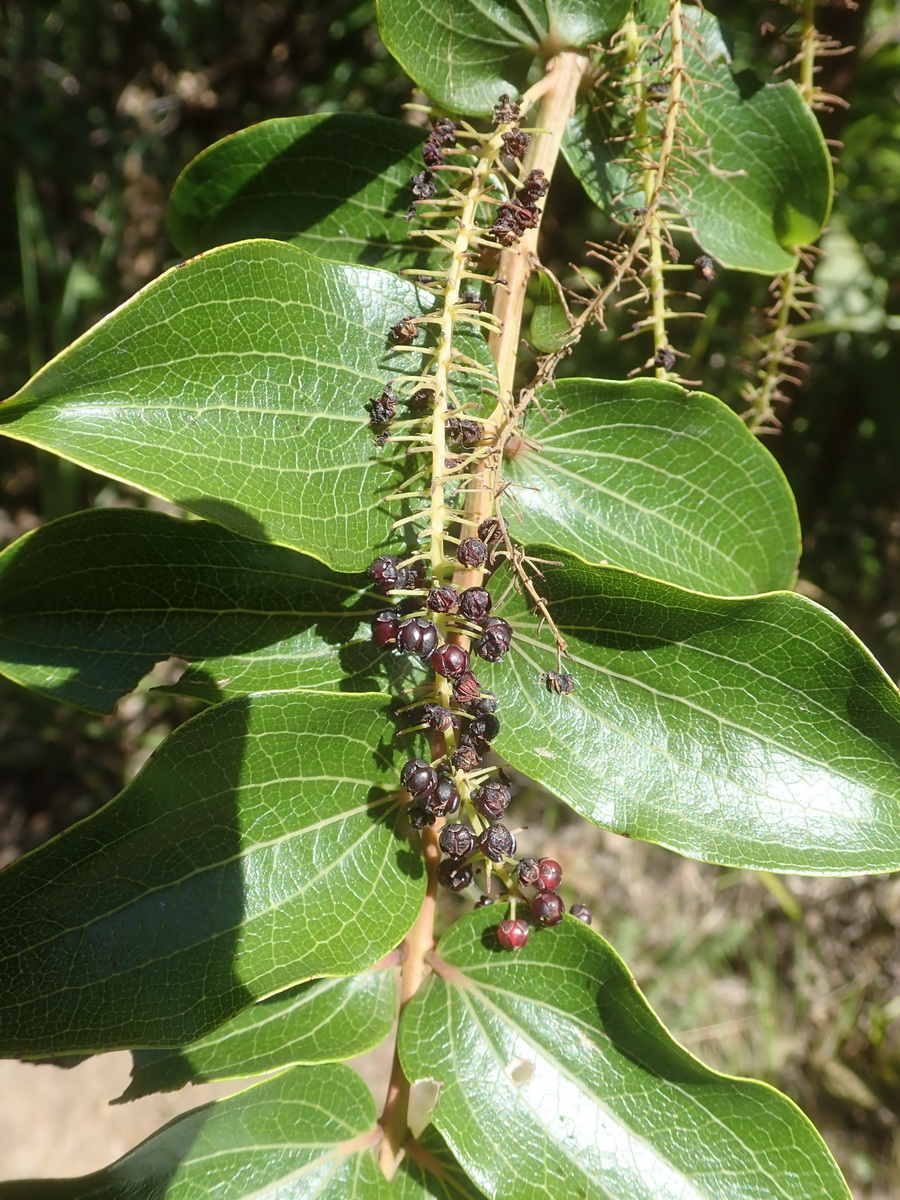Coriaria Arborea on:
[Wikipedia]
[Google]
[Amazon]
''Coriaria arborea'' is a highly poisonous and common native shrub or small tree of New Zealand. The common name for this and the other New Zealand species of ''Coriaria'' is tutu.
''Coriaria arborea'' is found in scrub and open areas from the coast to the hills across the country. A straggling plant, it can grow to high. The leaves grow opposite on slender stems while flowers are arranged in drooping

raceme
A raceme ( or ) or racemoid is an unbranched, indeterminate type of inflorescence bearing flowers having short floral stalks along the shoots that bear the flowers. The oldest flowers grow close to the base and new flowers are produced as the s ...
s. ''C. arborea'' is capable of nitrogen fixation
Nitrogen fixation is a chemical process by which molecular nitrogen (), with a strong triple covalent bond, in the air is converted into ammonia () or related nitrogenous compounds, typically in soil or aquatic systems but also in industry. Atmo ...
.
Ecology
''C. arborea'' plays host to several species of New Zealand endemic moth including '' Izatha austera'', ''I. churtoni'', '' I. mesoschista'' and '' I. peroneanella''.Uses
In spite of its toxicity, Tutu was consumed byMāori
Māori or Maori can refer to:
Relating to the Māori people
* Māori people of New Zealand, or members of that group
* Māori language, the language of the Māori people of New Zealand
* Māori culture
* Cook Islanders, the Māori people of the C ...
, specifically the extracted juice
Juice is a drink made from the extraction or Cold-pressed juice, pressing of the natural liquid contained in fruit and vegetables. It can also refer to liquids that are flavored with concentrate or other biological food sources, such as meat ...
from the fleshy flower petals. The gathered berries were placed in specially woven baskets lined with the flower heads of Toetoe, acting as a sieve to separate the poisonous seeds from the squeezed juice. The extracted juice is used as a sweetener to foods such as fernroot or was boiled together with seaweed and left to set as a black jelly called ''Rehia''.
Toxicity
The toxintutin
Tutin may refer to:
Places
*Tutin, Serbia, town in Serbia
Surname
*Arthur Tutin (1907–1961), English footballer
*Dorothy Tutin (1930–2001), English actress
*Mary Tutin, maiden name of Mary Gillick (1881–1965), English sculptor
*Tom Tutin (1 ...
is found in all parts of the plant apart from the fleshy flower petals. Tutu has been responsible for the most cases of livestock
Livestock are the domesticated animals raised in an agricultural setting to provide labor and produce diversified products for consumption such as meat, eggs, milk, fur, leather, and wool. The term is sometimes used to refer solely to animals ...
poisoning by any New Zealand plant. Dogs and even two circus elephant
A circus is a company of performers who put on diverse entertainment shows that may include clowns, acrobats, trained animals, trapeze acts, musicians, dancers, hoopers, tightrope walkers, jugglers, magicians, ventriloquists, and unicyclis ...
s have been poisoned by the plant. On occasion human poisoning has occurred through consuming honey where bees had interacted with the plant.
In 2014, a man tramping
Tramping may refer to:
Travel
*Hiking
*Trekking
*Tramping in New Zealand, a style of backpacking or hiking
* Czech tramping, a Czech outdoors pastime
Places
* Rural Municipality of Tramping Lake No. 380, Saskatchewan, Canada
** Tramping Lake, Sas ...
in Auckland
Auckland (pronounced ) ( mi, Tāmaki Makaurau) is a large metropolitan city in the North Island of New Zealand. The List of New Zealand urban areas by population, most populous urban area in the country and the List of cities in Oceania by po ...
, New Zealand looking to try the taste of the plant supplejack, mistakenly attempted to eat an asparagus
Asparagus, or garden asparagus, folk name sparrow grass, scientific name ''Asparagus officinalis'', is a perennial flowering plant species in the genus ''Asparagus''. Its young shoots are used as a spring vegetable.
It was once classified in ...
-looking young shoot of tutu. He said he did not actually eat any of the plant because of the revolting taste, but within hours he was having a tonic-clonic seizure that dislocated his arm, induced convulsions and made breathing difficult. Academic experts concluded he was lucky to survive the poisoning. A year later he had recovered fully apart from having some trouble with his memory.
Honey becomes contaminated when bees collect honeydew secreted by the passionvine hopper insect that feeds off the tutu plant. People have occasionally been hospitalised or even killed by honey contaminated with tutin. 1974 was the last case of commercial honey poisoning where 13 people were poisoned. Since 1974 there have been nine other cases of honey poisoning, with the most recent occurring in 1991 in the Bay of Plenty
The Bay of Plenty ( mi, Te Moana-a-Toi) is a region of New Zealand, situated around a bight of the same name in the northern coast of the North Island. The bight stretches 260 km from the Coromandel Peninsula in the west to Cape Runawa ...
and 2008 in the Coromandel
Coromandel may refer to:
Places India
*Coromandel Coast, India
**Presidency of Coromandel and Bengal Settlements
** Dutch Coromandel
*Coromandel, KGF, Karnataka, India
New Zealand
*Coromandel, New Zealand, a town on the Coromandel Peninsula
*Coro ...
. Periods of drought increase the risk of poisoning.

References
{{Taxonbar, from=Q3755414 Coriariaceae Flora of New Zealand